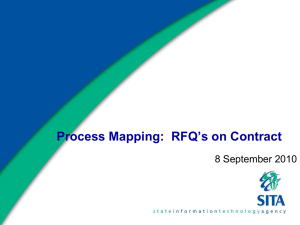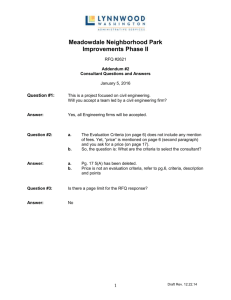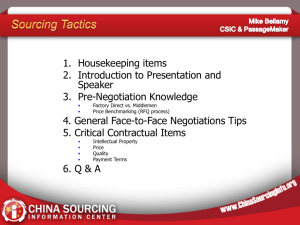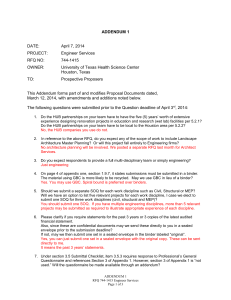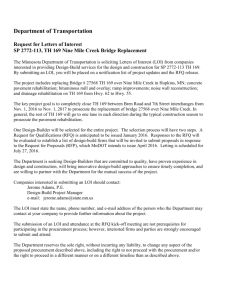Larry Stapleton Fri 1415
advertisement
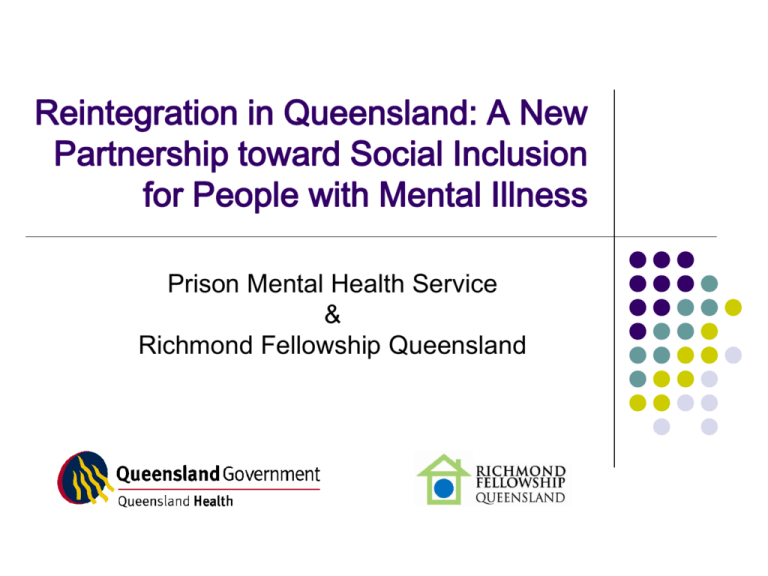
Reintegration in Queensland: A New Partnership toward Social Inclusion for People with Mental Illness Prison Mental Health Service & Richmond Fellowship Queensland Overview Description of both services – structure and service model Partnership – history, context Case Example Outcomes Future Prison Mental Health Service Component of Queensland Health Forensic Mental Health Service In-reach to 8 Correctional Centres in S.E. Qld Triage, Assessment and Treatment in Custody Psychological Intervention Diversion to health services Transitional Care Coordination Program Richmond Fellowship Queensland - RFQ Established in Brisbane in 1974, RFQ is a specialist provider of community rehabilitation and support services for people who have moderate to severe mental illness RFQ successfully tendered to Queensland Health to provide transition support for people leaving correctional facilities in South East Queensland and received funding in 2007 RFQ’s Transition Support Service has been operational for over 3 years RFQ Service Structure RFQ’s Transition Support Service office based in Annerley, Brisbane Coordinator and 6 Support Worker positions Primary Worker/Team Model Nominal individual caseload of 6 – 8 clients Services provided to 8 men’s and women’s correctional centres in South East Queensland TCP / TSS Service Model RELEASE DATE 1 month prerelease CUSTODY Prison Mental Health Service Prison Mental Health Service Care Coordinators Up to 6 months post-release NGO support workers (RFQ) COMMUNITY District Mental Health Service DFLO +/- CFOS District Mental Health Service Case Managers Up to 3 months pre-release 2 weeks post release RELEASE DATE Referral profile Prison Mental Health Service (PMHS) ‘open case’ load of around 1100 people at any one time Subset are eligible for Transition Care Coordination (TCC) from PMHS (around 100+ per annum) Who does PMHS select for TCC? Significant mental health needs Mental Health Act Status Active Illness Complex medication problems Requires case management in community Risk to successful transition of care At risk of homelessness Subset of this group (-80%) are referred to RFQ 7 The Partnership begins.. 2007 Early discussions TSS Established TCP established Referral criteria finalised meeting between clinicians and support workers to discuss potential referrals RFQ received first referral Regular management meetings And continued… 2008 Busy time for both services Meetings were less regular Mutual recognition that this did not meet our needs for communication etc Decision taken to meet regularly on a monthly basis (alternating management and clinical meetings) Development of TOR, agendas and venue 2009 - Current Bi-monthly Management meetings Bi-monthly clinical meetings Mutual case presentations Workshopping service models and processes Commencement of Transition Evaluation partnership Development of Service Level Agreement Shared CANFOR roll out & training Shared Conference presentation Management Meeting objectives To ensure a coordinated approach to maintaining and improving the collaborative relationship To focus on improving the links between the agencies To provide a forum for discussion of broader issues To ensure ongoing monitoring and annual review of the agreed Terms of Reference. Clinical Meeting Objectives To focus on improving the working relationship between the two agencies. To improve the mutual understanding of each agencies’ role in relation to referral processes, transition planning, community rehabilitation and support and case coordination. To provide a forum for information sharing; discussion and workshopping of individual case reviews; and issue identification and problem solving in relation to broader non-client specific issues. To provide a forum for discussion in relation to referral trends and patterns Case Example 38 year old Caucasian Australian female incarcerated (second time) for fraud in Brisbane Women’s Correctional Centre Health history: Schizophrenia Decreased Thyroid function Prejudicial childhood – neglect, poor parenting Social history: Limited social support network Parents deceased - Estranged from sisters Primary school education. Some experience as a hairdresser Iterant lifestyle Role of Transition Clinician (TC) Pre-Release Referred to transition program by her Psychiatrist 18 months before actual release date. Illness/ Medication education Liaison with formal networks: Lawyers, sentence management and MHS districts Brief CBT around problem thinking. Illness early warning signs Rapport building Discussion of mental health follow up Needs assessment Referral process PMHS TC Completed referral to RFQ June 2008 Client consent for referral Client completes RFQ Referral form PMHS send referral form to RFQ RFQ meet with client in correctional centre. Support Worker allocated PMHS informed of acceptance of referral. Role of RFQ pre-release Explain RFQ service model and philosophy Emphasise voluntary nature of service Client written consent to information sharing Discuss her needs and details of support provided Begin goal setting and informal planning Continue collaboration with PMHS Transition Planning Release date late December 2009 Court Ordered Parole An Individual Service plan (ISP) was prepared collaboratively with client TC identified emergency accommodation Client happy to stay in this accommodation until better options became available She also agreed to be referred to the district mental health service Emergency contact details were also included in the ISP Release Day activities On the day of her release from BWCC Client was extradited to NSW to face a Magistrates court on other matters Released from court in NSW on the day of her trial Client organised a bus and promptly returns to Qld Client contacts RFQ and returns to previously arranged accommodation TC informs MHS and confirms initial mental health appointment TC and RFQ accompany Client to G.P appointment 2 ½ months post release Client living in a Public Housing accommodation- a one bedroom unit on the esplanade in a Bayside suburb Ella with white goods worth $1500.00 with non-recurrent funds provided by Department of Communities. Washing Machine, Fridge, TV, DVD, Toaster and Juicer RFQ provides support 2 – 3 times per week and assists client with goal setting and activities planning RFQ 6 months post release Client now taking responsibility for parole obligations Client keeping G.P and MH appointments Mental state continues to be stable Client has dental needs addressed and is more fashion conscious Client commencing TAFE Considering renewing contact with sisters Client Outcomes Early local outcome data positive Good anecdotal evidence High 6th month program engagement rate High client satisfaction survey results Partnership Outcomes Continued willingness to work collaboratively Mutual respect and understanding Forums established to problem solve/manage: Staff performance issues Management of risk Systemic Issues Complex and chaotic environment Future Plans • Continuing current meeting formats • Research and Evaluation •Data collection •Improving inter-rater reliability (CANFOR, HONoS) • Collaboration in relation to roll out of Maryborough TSS •Increase collaboration & Network building (Housing, D & A, Employment) Contact Information Julie Evans (07) 32718729 Julie_evans@health.qld.gov.au Larry Stapleton (07) 33632640 Larry.Stapleton@rfq.com.au
